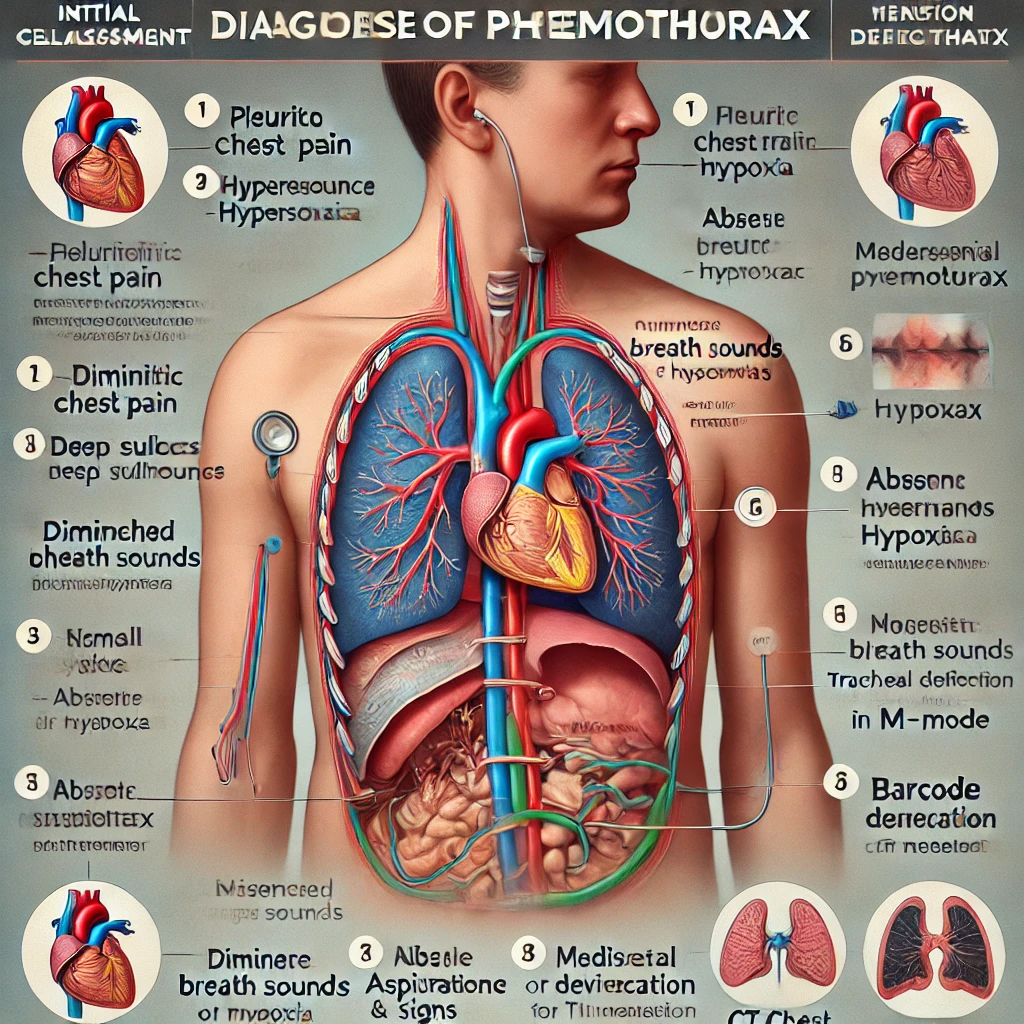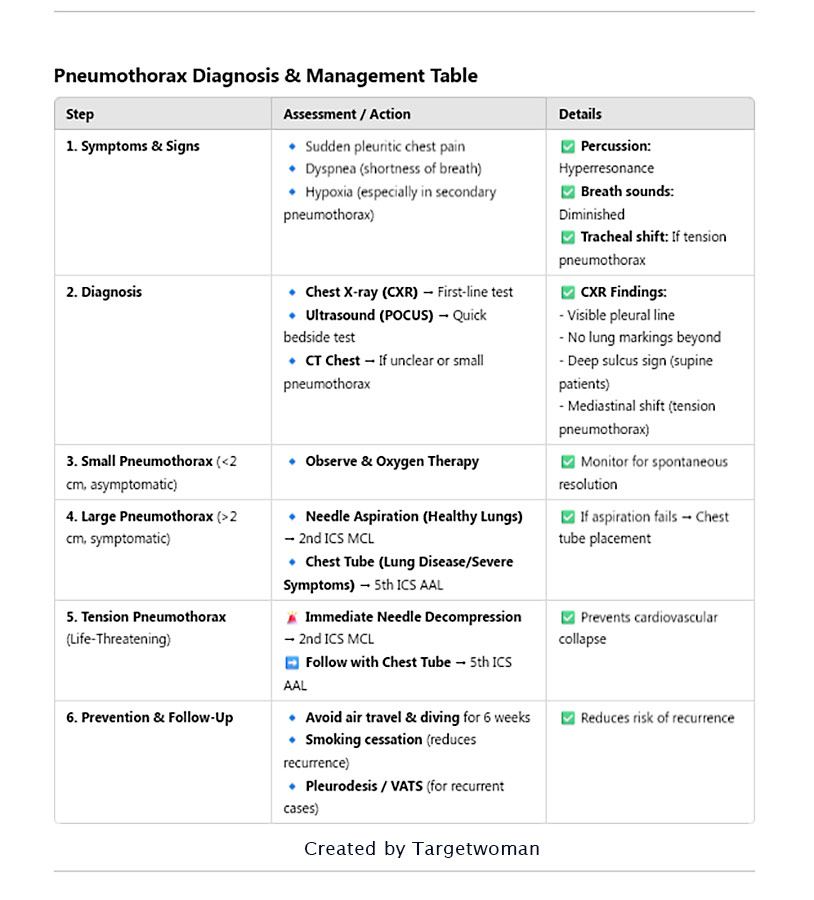Pneumothorax
Pneumothorax is the presence of air in the pleural space, leading to lung collapse. It occurs when air leaks into the space between the visceral and parietal pleura, disrupting the negative pressure required for lung expansion.
Types of Pneumothorax:
Spontaneous Pneumothorax (Non-traumatic)
Primary: Occurs in individuals without underlying lung disease, often in tall, thin young males due to ruptured subpleural blebs.(small, air-filled blisters or cysts located on the outer layer of the lungs - the pleura)
Secondary: Occurs in patients with pre-existing lung disease (e.g., COPD, asthma, cystic fibrosis, tuberculosis).
Traumatic Pneumothorax
Blunt Trauma (e.g., rib fractures puncturing the lung).
Penetrating Trauma (e.g., stab or gunshot wounds).
Iatrogenic Causes (e.g., central line insertion, mechanical ventilation, lung biopsy, thoracentesis).
Tension Pneumothorax (Life-Threatening)
Progressive accumulation of air without escape, increasing intrapleural pressure, leading to mediastinal shift, reduced venous return, and cardiovascular collapse.
Requires emergency needle decompression followed by chest tube insertion.
Catamenial Pneumothorax
A rare form associated with menstruation, often linked to thoracic endometriosis - where endometrial tissue, typically found in the uterus, grows outside the pelvis, specifically in the chest cavity.
Clinical Presentation
Symptoms:
Sudden onset pleuritic chest pain
Dyspnea - shortness of breath (varies with severity)
Hypoxia (more common in secondary pneumothorax)
Signs:
Hyperresonance on percussion
Diminished breath sounds on the affected side
Decreased tactile fremitus (palpable vibration felt on the chest wall during speech or vocalization, assessed by placing hands on the patient's chest and having them speak).
Tracheal deviation (if tension pneumothorax)
Diagnosis:
Chest X-ray (CXR) – First-line Investigation
Visible pleural line with no lung markings beyond it.
Deep sulcus sign (in supine patients).
Mediastinal shift in tension pneumothorax.
Ultrasound (POCUS)
Absent lung sliding and barcode sign (M-mode).
CT Chest (if needed)
More sensitive, useful in small or complex cases.
Management:
Observation (Small, Stable Pneumothorax)
If less than 2 cm rim and patient is asymptomatic → Oxygen and monitoring.
Spontaneous resolution expected within days.
Needle Aspiration (Moderate Cases)
Indicated for primary pneumothorax if symptomatic.
Large-bore needle (14-18G) in 2nd ICS MCL (midclavicular line).
Chest Tube (Thoracostomy) – Definitive for Large or Unstable Cases
5th ICS, anterior axillary line (safe triangle).
Water-seal drainage prevents air re-entry.
Tension Pneumothorax – Emergency Management
Immediate needle decompression in 2nd ICS MCL → Followed by chest tube placement.
Surgical Management (for recurrent cases)
Pleurodesis (chemical or surgical)
Thoracotomy or VATS (Video-Assisted Thoracoscopic Surgery) for persistent leaks.

Spontaneous pneumothorax is a condition where the lung collapses due to accumulation of air or gas in the chest. The lung caves in due to inability to fill up with air during inhalation. This can happen to thin tall men without any prior symptoms. Spontaneous pneumothorax is more pronounced among men, especially smokers. Primary spontaneous pneumothorax occurs without any history of lung disease. It is usually attributed to the rupture of a air-filled sac within the lung. Secondary spontaneous pneumothorax is noticed among persons who are suffering from chronic obstructive pulmonary disease, tuberculosis, pneumonia, asthma, cystic fibrosis or lung cancer.
Primary spontaneous pneumothorax usually occurs in persons less than 40 years. On the other hand, secondary spontaneous pneumothorax is noticed among older patients. Sudden shock or low blood pressure or distended neck veins can bring on a condition of tension pneumothorax. This type of pneumothorax can also result from a serious accident or violent crime.

Breathlessness is the most prominent symptom of pneumothorax. There is dull or stabbing pain in the chest that is accentuated by coughing. A patient suffering from spontaneous pneumothorax experiences shortness of breath and abnormal breathing pattern. The patient feels agitated and enlarged neck veins will be observed. A physician will conduct a thorough physical examination and listen to your heart and breath sounds if he suspects a spontaneous pneumothorax condition. A chest x ray can confirm the collapse of the lung. The level of oxygen in the blood is measured with a pulse oximeter or an arterial blood gas analysis.
Treatment for spontaneous pneumothorax involves removal of air from the pleural space so as to allow the lungs to expand again. It may take several days for the lungs to re expand. A Catheter is used for aspiration of air from the pleural cavity. A chest tube is placed between the ribs to allow the air to be evacuated from that space. Doxycyline may be passed through the chest tube to seal the space.
- Quit smoking
- Avoid scuba diving and flying in aircrafts without sufficient pressure control
- Sleep with your head at elevated position
At TargetWoman, every page you read is crafted by a team of highly qualified experts — not generated by artificial intelligence. We believe in thoughtful, human-written content backed by research, insight, and empathy. Our use of AI is limited to semantic understanding, helping us better connect ideas, organize knowledge, and enhance user experience — never to replace the human voice that defines our work. Our Natural Language Navigational engine knows that words form only the outer superficial layer. The real meaning of the words are deduced from the collection of words, their proximity to each other and the context.
Diseases, Symptoms, Tests and Treatment arranged in alphabetical order:

A B C D E F G H I J K L M N O P Q R S T U V W X Y Z
Bibliography / Reference
Collection of Pages - Last revised Date: December 12, 2025



